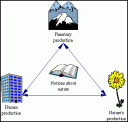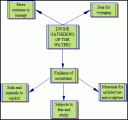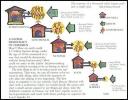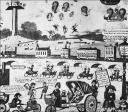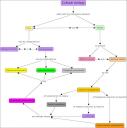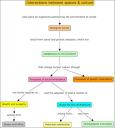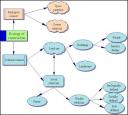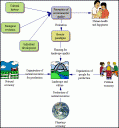The Nobel Peace Prize nominee Thich Nhat Hanh, a follower of the Vietnamese Zen Buddhist tradition, has coined the term interbeing to express the reality of mutual interdependence in human relationship, both in the sense of relating one to another and in the wider sense of humanity’s relationship to the natural world as a whole. Hanh’s presentation of “interbeing” is rooted in the philosophical foundation of Zen Buddhism.
The ancient religious traditions of India (Theravada and Jainism) have been characterised by an unusual sensitivity to living beings. The Buddhist codes of ethics are similar to the Jaina ethics of Hinduism, with much emphasis placed on self-control, abstinence, patience, contentment, purity, truthfulness and right attitudes. The treatment of animals and plants in accordance with these principles finds ample references in Buddhist texts, from the earliest monastic codes to the development of Chan or Zen Buddhism in China, Korea and Japan. Monks of these traditions are strictly forbidden from harming any life form, including even the smallest insects and plants. One of the basic ideas behind the Buddha’s teaching of mutual interdependence is that ultimately there is no demarcation between what appears to be an individual creature and its environment. Harming the environment is thus, in a major sense, harming oneself. This philosophical position lies at the heart of modern-day deep ecology and some representatives of this movement have shown that Buddhist philosophy provides a rational basis for deep ecological thinking. Deep ecology is a contemporary ecological philosophy that claims to recognize the inherent worth of other beings aside from their utility. The philosophy emphasizes the interdependent nature of human and non-human life as well as the importance of the ecosystem and natural processes. It provides a foundation for the environmental, ecology and green movements and has fostered a new system of environmental ethics.
The Buddha based his teachings on the premise that there is suffering in the human condition and our relationships with the environment. The appropriate moral response is to minimize human suffering and pain as best as one can by understanding the causes and by alleviating the suffering of all forms of life. This ethic covers human behaviour in relation to all living beings and it underpins certain basic virtues, particularly compassion, love, kindness, sympathy, empathy, equanimity and joy in the others happiness. Only recently the Dalai Lama has stressed that human beings are capable of an infinite amount of compassion, generosity and gratitude, and that all creatures, great and small, should be the subject of our moral sensibility to improve the welfare of all sentient beings. Nature in relation to human needs is regarded as capable of making a contribution towards overcoming suffering and the final spiritual end, which human beings strive toward. The Buddhas teachings include tales of acts of generosity on the part of animals towards human beings, and the reciprocal compassion which humans are advised to direct towards other life forms. Buddhist societies evolved with this moral self-consciousness at all levels of society, which places non-theistic spiritual values at the centre of cultural ecology to support technological development with a corresponding inner development. This inner spiritual world is expressed in poetry, which explicitly bears an intellectual and spiritual message. Scientific logic and poetry complement each other and point to realities, which encompass both of them.
Non-theistic spirituality
If evidence of declining attendance is accepted, people may not want church, but they do appear to question a purely materialistic view of life. They want to believe in something more, even if they do not know-or want to know – what that something is. This missing something is spirituality, which is related to:
· a connection to what many refer to as the Life-force, God, a higher power or purpose, Great Mystery, or Buddha Nature;
· a sense of wholeness, healing, and the interconnectedness of all things;
· meaning-making;
· the ongoing development of one’s identity (including one’s cultural identity) moving toward greater authenticity;
· how people construct knowledge through largely unconscious and symbolic processes manifested through image, symbol, and music, which are often cultural. In all these aspects spirituality is related to culture.
Culture is the common set of beliefs, values, language, images, symbols, and behaviours shared by a particular social group. Nearly all human knowledge and experience, including spiritual experience, will be shared and given expression through culture–in language, in music, in art, or in symbol making. Indeed, people construct knowledge and make meaning in powerful and unconscious ways through symbol, music, art, metaphor, and ritual referred to as “symbolic” and “unconscious structuring processes”. These aspects of knowledge production and ways of knowing are at the heart of the way spiritual knowing is often expressed. But such manifestations of knowing through symbolic and unconscious processes are also deeply cultural.
In addition, spirituality is different from, but for some people, related to religion. Generally, the term “religiousness” is used to mean adherence to the beliefs and practices of an organized church or religious institution. However, in the present context, “spirituality” is used to refer to a unique, personally meaningful experience. A spiritual response to life is possible without supernatural elements and entities. A spiritual life can be based on the combined objectivity of science and the emotional subjective responses to shapes, sounds and colours in the natural world. Part of this spirituality is the wonder and awe that can exist without science, but which science amplifies. This non-theistic spirituality provides a sense of humility and exuberance, and a reverence for a mysterious, magnificent Universe.
Although spirituality may include various forms of religiousness, spirituality does not necessarily involve religiousness. Paul F Knitter in his book Without Buddha I could not be a Christian writes of how, as a priest, he had to rethink the idea of God as a transcendent “Other” – a supernatural Being who exists apart from us in a heavenly realm. Most people envision God as an external Man-In-The-Sky, separate from other finite beings, who can be petitioned by prayer to intervene supernaturally in human history. This is the theistic God. Knitter tends to think of god non-theistically as “The Ground of Being”, an inherent product of human socialisation emanating from and connecting all humanity. He said the Ground of Being is a:
“personal creative, sustaining vitality that “persuades and influences us all, calling us to relationships of knowing and loving each other, energizing us when such relationships get rough, filling us with the deepest of happiness when we are emptying ourselves and finding ourselves in others.”
Thich Nhat Hanh, the renowned Vietnamese Zen teacher, has defined this unifying social mindfulness as the concept of Interbeing. Being mindful is the most important precept of all in Buddhism. This state of super-awareness is to is to know what is going on
to be aware of what we do, what we are, minute by minute. The spiritual significance of interbeing is the realization that there is no independant self that the perception of self, of me, of mine is an illusion. As an example of interbeing he establishes that a sheet of paper is everything in the world: the cloud, the rain, the sun and earth that fuel the tree; the logger who cuts it down; the mill; the hand that touches it, writes on it, reads from it
. All is one. What we do to one person, we do to ourselves.. This is why all art, even all objects made by humankind, holds the imaginative keys to mindful awareness.
When we are truly mindful, we recognize that nothing in life is any more permanent or secure than an ocean wave. We are always riding the crest of a wave. To try to hold on to anything is to pursue an impossible illusion of security. When we accept the truth of this impermanence, we realize that all boundaries are human constructs imposed by the imagination on the unpredictable, and therefore uncontrollable, process of reality. So, when we are in the grip of interbeing, we make no effort to control or impose ourselves on others. We simply respond to the demand of the moment, without expecting to control the future. Nhat Hanh applies the same lesson to the newest expression of non-violence, which is non-violence against nature. He suggests that interbeing offers the most powerful basis for living sustainably. He would say that just as every person is within me, bound to me in interbeing, so is all of nature. Nature is our “larger self.” All our environmental problems stem from the illusion that there is a basic difference between the human self and nature. Once we see through this illusion, we extend our compassion to every other living being. We respond immediately, in the present moment, to suffering anywhere in nature. But we understand that suffering anywhere is our own suffering. So we must also take care of nature to ease our own suffering. We need the right kind of natural environment to get personal harmony, and we need personal harmony to have the right kind of natural environment. “The best way to take care of the environment in this two way interaction is to take care of the environmentalist.”
The best way to take care of the environmentalist is to grow in non-violence, in mindful awareness of the truth of interbeing. The proposition from Nhat Hanhs teachings is that it is vital to promote mindful awareness to produce the state of interbeing for living sustainably. This does not mean we have to become Buddhists to practice interbeing. For example, Friedrich Schumacher, the Western secular economist, best known for his book Small is Beautiful, recognised many of the present day dysfunctionalities of classical economics in his essay, Buddhist Economics. This work is taken as a precedent in an attempt to ask what our socio-economic, cultural and political institutions would look like, if they were modeled on Buddhist interbeing principles. It is an attempt to move back from a state of collective disembodiment, to one of a mindful recognition of, and re-embodiment in, our natural world.
Thich Nhat Hanh, in his The Fourteen Precepts from Interbeing, (2003) listed the following principles of interbeing that could be taken up by theists and atheists alike, along with environmentalism.
“1. Do not be idolatrous about or bound to any doctrine, theory, or ideology
2. Do not think the knowledge you presently possess is changeless, absolute truth
3. Do not force others, including children, by any means whatsoever, to adopt your views
4. Do not avoid contact with suffering or close your eyes before suffering
5. Do not accumulate wealth while millions are hungry
6. Do not maintain anger or hatred
7. Do not lose yourself in dispersion and in your surroundings
8. Do not utter words that can create discord and cause the community to break
9. Do not say untruthful things for the sake of personal interest or to impress people
10. Do not use the community for personal gain or profit
11. Do not live with a vocation that is harmful to humans and nature
12. Do not kill, do not let others kill
13. Possess nothing that should belong to others
14. Do not mistreat your body, learn to handle it with respect”
The connection between spirituality and cultural ecology is to do with our inner sense of connection with something larger than ourselves and with our relationship with what we see as sacred. This can give our lives a sense of meaning and purpose beyond material success and those special moments where we feel that a deeper connection with all sentient beings can provide an important source of strength in difficult times.
If we see ourselves as part of the ‘Tree of Life’ – the web of beings linked through food chains and evolution, then a Deep Ecological approach to spirituality might emphasise our relationship with this larger whole. We may look at life itself as being sacred, and see the possibility of the larger force of life acting through us in our work for earth recovery. This ‘life-centred spirituality’ can be an important source of inspiration to face and respond to environmental problems at the interface between culture and ecology.
Open commensality
Centuries of secularism have failed to transfer the ecological principle of eating into something strictly utilitarian. Food is still treated as a cultural pillar with mindful reverence. A meal is still a rite the last natural sacrament of family and friendship, symbolic of life that is more than eating and drinking. To eat is still something beyond maintaining bodily function. People may not understand what that something is, but they nonetheless desire to celebrate it. They are still hungry and thirsty for sacramental life. To know what where, how, when and with whom people eat is to know the character of their society. Jesus of Galilee kept an open table and practiced what Father John Dominic Crossan has called open commensality. Christ constantly expressed his love of beings and life in feasts. The Gospels tell how Jesus was accused of eating with tax collectors, sinners and whores, which was the shorthand of the Jewish priesthood for him embracing untouchables, widows, the poor, the maimed and the marginalized. This was an important part of his determination through his radical egalitarianism to reverse all the precedents of contemporary Jewish society, which was ordered by a purity system of irrational do nots. The simple, non-revolutionary, quietist commensalism of Jesus established a network of compassion through his band of misfits and outcasts, which welcomed non-Jews and slaves to their tables of companionship.
A non-theistic social form of commensalism has always been evident in human society. For instance, the human market place has always functioned in this mode when the establishment of one business gives rise to other, adjacent ones that take nothing from the first. In post industrial cities there were quarters for butchers, tailors and metalworkers. Perhaps the best non-theistic modern example is concessionaires at sports and entertainment events.
Also, if some big firm opens a business in a neighbourhood, other, smaller, firms often start up around it. Nothing is taken from the larger firm in the process. This commensal economic relationship may be an alternative to what many see as the allegedly zero sum relationship of capitalism, whereby the gain of one must involve a loss to others. Indeed, a great many people see the market place as a kind of boxing ring so that for one to win another must lose. In fact, the market place is much more akin to an endless marathon race. There is a long time span of often changing positions, with some even attaching themselves “commensally,” so as to follow the right pace at which to proceed or to shield oneself from head wind.
Commensalism is fundamentally a biological principle. Many animals and plants live in what is called a “commensal” fashion. This is to say that some of them feed or otherwise gain benefits from the activities of others without depriving these other beings of anything at all. This distinguishes commensalism from parasitism, whereby some animals feed off the bodies of others, depriving these others of something valuable.
Commensalism may well operate on a global scale through the Gaian System. The Gaia Theory asserts that living organisms and their inorganic surroundings have evolved together as a single living system that greatly affects the chemistry and conditions of Earths surface. Some scientists believe that this Gaian system self-regulates global temperature, atmospheric chemistry, ocean salinity, and other factors in an automatic manner. It is their explanation of how the Earth’s greater living system appears to keep conditions on our planet just right for life to persist! Gaia is thought of by many people to be the ultimate organism, made up of all living things on the planet. However, most scientists consider Gaia to be an emergent property of the biosphere acting upon the lithosphere, which just happens to keep the planet habitable in the long-term. The Gaia hypothesis emphasizes that cooperation is far more important for stability of the biosphere than is competition. In this light, Gaia can properly be thought of as a commensal meta-organism that is composed of a biochemical network of all other organisms.
Therefore, Christian open commensalism that has come down to us from the early church may be taken as an example of interbeing based on the ecological unity of all beings through the sharing of food chains. The other feature of this unifying ecological network is light. For Jesus, the entire creation and all the beings at every level in it were linked to humanity through a vast sea of the light of the world. As the evangelist Thomas tells us in his Gospel, Jesus is identified with human light consciousness that symbolizes universal bonding of people through mindfulness that truth and love are the unifiers of humanity with all other beings.
It is I who am the light which is above them all. It is I who am the all. From me did the all come forth. Split a piece of wood and I am there. Lift up the stone and you will find me there.
Imagination in place
In 1806, John Forster in a series of letters to a friend warned of the dangerous essence of the romantic meditative movement, with its emphasis on the interpretation of environment through imagination rather than logic.
“Imagination may be indulged till it usurp an entire ascendancy over the mind, and then every subject presented to that mind will excite imagination instead of understanding to work; imagination will throw its colours where the intellectual faculty ought to draw its lines; imagination will accumulate metaphors where reason ought to deduce arguments; images will take the place of thoughts and scenes of disquisitions. The whole mind may become at length something like a hemisphere of cloud scenery, filled with an ever-moving train of changing melting forms, of every colour, mingled with rainbows, meteors and an occasional gleam of pure sunlight, all vanishing away, the mental like this natural imagery, when its hour is up, without leaving anything behind but the wish to recover the vision. And yet, . . . this series of visions, may be mistaken for operations of thought, and each cloudy image be admitted in the place of a proposition, or a reason; and it may even be mistaken for something sublimer than thinking.”
Cultures are built on an invented set of agreements, rules of conduct by which everyone must live. But because the individuals of a particular culture lack a personally validated knowledge of the most essential aspects of their lives and existence, they crave understanding, and in places where they cant find any, they use their imagination to invent a story to fill the void. Forster’s fears of the predominance of imagination over judgement in the evaluation of place were not a problem to later writers. Charles Kingsley’s fictional character Alton Locke, the Chartist poet of the Victorian urban fringe, discovers the work of Tennyson and is overwhelmed by the pleasure of imaginative recognition. …
“he has learned to see that in all Nature, in the hedgerow and the sandbank, as well as in the alp-peak and the ocean-waste, is a world of true sublimity – a minute infinite – an ever fertile garden of poetic images, the roots of which are in the unfathomable and the eternal, as truly as any !….. phenomenon, which astonishes and awes the eye. The description of the desolate pools and creeks where the dying Swan floated, the hint of the silvery marsh mosses by Marianas moat, came to me like revelations. I always knew there was something beautiful, wonderful, sublime, in those flowery dykes of Battersea Fields; in the long gravely sweeps of that lone tidal shore; and here was a man who had put them in words for me. This is what I call democratic art – the revelation of the poetry, which lies in common things. And surely all the age is tending in that direction; in Landseer and his dogs – in Copley Fielding and his downs, with a host of noble artists – and in all authors who have really seized the nation’s mind from Crabbe and Burns and Wordsworth to Hood and Dickens, the great tide sets ever outward, towards that which is common to many, not that which is exclusive to the few . . .”
In the character of Alton Locke, Charles Kingsley was beginning to articulate dissatisfaction with urbanisation and the loss of the joys and dangers of belonging to a semi-natural countryside, which, for millennia had been the daily discourse of humankind. One of the key figures in shaping a modern educational movement to end this lonely, often desperate, isolation of Homo sapiens from other species was the American Joseph Wood Krutch (1893-1971). “We are all in this together,” he concluded in 1949, not long after he finished writing a biography of Henry Thoreau, one of the first American environmentalists. Once a rather melancholic humanist, Krutch now became a kind of pantheist or ethical mystic, caught up in the joy of belonging to “something greater than one’s self.”
Thoreau again and again was partly responsible for the radical change in Krutch’s outlook. The other chief stimulus was a self- education in ecological principles. “Every day,” he observed, “the science of ecology is making clearer the factual aspect as it demonstrates those more and more remote inter- dependencies which, no matter how remote they are crucial even for us.” Krutch’s self-tutoring in science confirmed him in an organismic sensibility, partly pragmatic, but more fundamentally ethical.
It is now widely accepted scientifically that we must be a part not only of the human community, but also of the whole ecological community. We must acknowledge some sort of biochemical oneness not only with our neighbours, our countrymen and our civilization, but also have some respect for the natural as well as the man- made community. Ours is not only “one world” in the sense usually implied by that term. It is also “one earth.” It is abundantly clear that our species requires behavioural adaptations for long-term survival, based on the political and economic interdependency of nations and communities. It is not a sentimental but a grimly literal fact that unless we share planet Earth with creatures other than ourselves, we shall not be able to live on it for long. This behavioural change will involve making conservation management central to economic development.
Science has led directly to a moral awakening: a new sense of biological relatedness and communalism. However, Krutch perceived that ecology, “without reverence or love,” could become naught but “a shrewder exploitation of what it would be better to admire, to enjoy, and to share in.” His own approach to the embryonic science of ecology helped turn him from the pursuit of self toward a “sense of the community of living things.” Spirituality makes the connection.
The fact that Krutch equated reverence with love is particularly interesting in that the development of Christianity placed love alongside the Greek virtue of justice as a supreme ordering feature of human life. The centrality of love to Christian ethics was stressed by St Augustine who pronounced that the quality of any society could be measured by the honour and dignity of common objects that humans love. Thus, the view of a heron standing patiently beside a pond and the warmth of a pair of gloves are meditative contributors to human wellbeing, which when they are encountered remind us that continuous economic growth is not the fundamental source of human happiness.
Human capabilities for living sustainably
Nature religions are not attempts to control nature but systems to help put individuals in accord with ecosystems. Ake Hultkrantz affirmed this position emphasizing the ecological integration of religious thinking and practice among indigenous native populations. He declares that there is a “cosmotheistic interpretation of nature,” which is operative among these traditions through meditation on natural features. As a consequence, the Great Mystery, the sacred, is manifest throughout the natural world. For traditional cultures, there is, accordingly, a sacred unity of nature and humanity that requires the moral acknowledgement of wild nature through contemplating landscape, by walking through it, or making/viewing pictures of it. The result of these beliefs is that the spiritual values of nature are fully integrated into all aspects of social, cultural, and environmental activity. Manifest nature is of definitive significance in traditional spiritual practice, which assigns special conservation status to local rocks, streams and mountains. For example, drawing on many of the themes associated with sacred mountains around the world, The Mountain Institutes (TMI) Sacred Mountains Program has been working with the US National Park Service since 1998, developing innovative interpretive and educational materials and activities that highlight the evocative spiritual and cultural meanings of natural features of mountain environments. These places range from peaks and their dependent rivers to forests and wildlife, in American, Native American, Native Hawaiian, and other cultures around the world.
This is only to say that as sacred expressions of some deeper reality, mountains have become associated with the deepest and highest values and aspirations of cultures and traditions. The remote Himalayan peak of Mount Kailas directs the minds of millions of Hindus and Buddhists toward the utmost attainments of their spiritual traditions. Mount Sinai occupies a special place in the Bible as the seminal site where Moses received the Ten Commandments, the basis of law and ethics in Western civilization. The picturesque cone of Mount Fuji has come to represent the quest for beauty and simplicity that lies at the heart of Japanese culture. Mount Everest stands out, even in the modern, secular world, as an inspiring symbol of the ultimate human challenge of self against nature. Therefore, the mountains, as the highest and most impressive features of the landscape, have an unusual power to awaken a meditative sense of the sacred. Their soaring summits, the clouds and thunder that swirl about their peaks, the life-giving waters that flow from their heights, these and other characteristics imbue them with an aura of mystery and sanctity. In that aura, people of diverse backgrounds, both traditional and modern, experience a deeper reality that gives meaning and vitality to their lives. Drawing on many of the powerful educative themes associated with sacred mountains around the world, the TMI has developed innovative educational activities that highlight general spiritual and cultural meanings of natural features. The purpose of the project is to connect a broad range of visitors with nature back home in order to enrich their local experiences, and give them deep-seated, reasons for meditating on sustainable livelihoods at the neighbourhood level and adopting the behavioural changes necessary to mitigate the effects of climate change.
Fig 1 The sustainable livelihoods framework for adapting to climate change

www.poverty-wellbeing.net
A livelihood comprises the local capabilities, assets (including both material and social resources) and activities required for a means of living. A livelihood is sustainable when it can cope with and recover from stresses and shocks, maintain or enhance its capabilities and assets, while not undermining the natural resource base. In fact, being sustainable is not only increasingly necessary, but judging from the success of the TMI programmes can also be a fulfilling, enjoyable and enriching experience.
A prevalent view of society undergoing behaviour change is to develop the communal setting as the outcome of a contract between independent individuals who seek to promote their individual interests. Individuals first exist as distinct persons, and they then form relationships and engage in co-operative arrangements with one another, for the sake of the greater individual advantage. In that framework, the communal setting is seen as a set of individuals who have no links together except a binding common advantage. That particular vision of seeing the world composed of individual selves is known as methodological individualism. This is a widely used term in the social sciences. Its advocates see it as a philosophical method aimed at explaining and understanding broad society-wide developments as the aggregation of decisions by individuals. The term was originally coined by Joseph Schumpeter in 1908 according to which all social phenomena must be accounted for in terms of what individuals think and choose and do. This is the basis of Brad McManus integral framework for living sustainably, which stresses that behaviour change has to come about through an holistic combination of science and technology, with an individual mindset that brings to bear individual wisdom and morality to work with nature and not against it. This is set out in the following map of the necessary behaviours expressing human capabilities in relation to self, others and the objective world. The idea is for individuals to become part of a sustainable livelihoods framework to facilitate them to pursue their own goals rather than being perceived as victims or simply beneficiaries from top-down organizational prescriptions.
Inner subjectivity of the individual self
Practice meditation.Undertake some personal development.
Articulate your personal vision and values.
Experience fully what you are doing in the moment.
Be more observant of your senses and surroundings.
Reassess what is and is not important in your life.
Rediscover what motivates you and makes you happy.
Strive for personal freedom and do the things you enjoy.
Learn how our emotional state affects you and others.
Express your creativity in music painting or dance.
Inner subjectivity of the collective self
Learn what currently shapes and limits your worldview.
Be less judgemental and more tolerant of others.
Understand that cross-cultural differences do exist.
Practice random acts of kindness towards others.
Participate in a social activity or event.
Spend time with your family and friends.
Volunteer to assist a local group or association.
Rather than email someone talk to them.
Share your skills and knowledge with others.
Introduce yourself to neighbours.
Exterior objectivity of the individual self
Read or study to expand your knowledge.
Restore balance between work and personal life.
Calculate food miles when buying groceries.
Read food labelling and select carefully.
Reassess your consumption patterns.
Exercise regularly and have a medical check up.
Grow some of your own fruit and vegetables.
Improve you personal self-sufficiency.
Choose durable and reusable goods.
Assume personal responsibility for your life choices.
External objectivity of the collective self
Apply principles of living sustainably at home and work.
Reduce electricity consumption.
Design energy efficient homes and workspaces.
Reduce consumption of unnecessary goods and services.
Harvest rainwater and use water more frugally.
Distribute surplus donate unwanted goods to a charity.
Reduce your level of financial debt.
Use technology but do not depend on it.
Reuse and recycle waste where practical and safe.
Use public transport instead of driving a car.
The concept of sustainable livelihoods is an important approach in development studies, and has mainly been utilized for poverty reduction. According to the concept, poverty must be understood in terms of capability deprivation. Livelihood contexts are dynamic and vary widely, as they are specific and based on the level of development of the targeted country or region, allowing for a more holistic view of poverty. The typical situation of these populations that are commonly referred to as deprived, marginalized or urban poor is the following:
All, in one tragic sense, are on the margins, not just of economy, but of society. As workers, they are poorly paid for long hours of work, often in impermanent, hard labour, dirty and dangerous occupations that do not make them eligible for whatever meager social security benefits exist. Residentially, they live in one or another kind of inadequate housing: old slums, new tenements, and shantytowns. As consumers, they lack the purchasing power to purchase the goods and services enjoyed by the rest of society. Socially, their status is that of the insulted and injured; culturally, they lack formal education, sometimes even the ability to speak the national language.
There are special factors to be addressed at the margins of society in order to achieve a situation of sustainable livelihoods. The target group must receive support that enables it to increase income and well-being. Typical examples are just and equitable pay for work, gender equality, decent housing, higher food security, sustainable use of the natural resources base and a reduction in vulnerability to sudden changes or shocks. Achievements have to be analysed against the background of the policy and institutional framework in the respective countries. In order to define interventions accordingly, there must be a proper understanding of how livelihoods can be sustainable in the particular environmental context. For a person living in a city, natural capital is less important, for example, than for a person that lives in the countryside and makes a living from agriculture.
Frameworks of sustainable livelihoods approaches (Fig 1) have been developed by numerous organizations engaged in the field of international development, among them the World Bank, the International Fund for Agricultural Development (IFAD), Food and Agricultural Organization (FAO), Department for International Development (DFID) and many others. Sustainable Livelihoods Frameworks are:
· Flexible and can be adapted by organizations and teams to meet their specific needs, by, for example focusing on specific aspects than others without losing sight of the wider picture
· Are people centred and thus favour participatory and multidisciplinary approaches and multilevel development interactions. In this way, SLFs provide useful tools to incorporate asset limitations into other thematic foci
· Focus on peoples own strategies to enhance their capabilities and assets as a basis for better and more sustainable livelihood outcomes
· Enable a multi dimensional approach to factor analysis and reduction and can be used to illustrate how interventions that tackle the non material dimensions of poverty, can contribute to strengthening a households asset portfolio, enhancing their livelihood options and enhancing heir well-being
· Allow a focus on who is specifically vulnerable to shocks and stresses because of limited assets and capabilities thus identifying those likely to drop our of the system
· Acknowledge the diversity of asset combinations both tangible and intangible and how people interact with dynamic contextual factors to develop a wide range of livelihood strategies
· Support the development of peoples capabilities (understood as human outcomes of the quality of peoples lives including leading a life free of avoidable morbidity, being informed and education and being well nourished), which are both a prerequisite for, and result of empowerment. This illustrates that SLFs go well beyond material asset creation of income generation
· Are focused on mirco level outcomes for the individual or household but encourage analysis to consider how context might influence specific outcomes and how policies and institutional processes and structures might affect different groups of people categorized by their assed limitations.
Moral naturalism
Among moral prescriptions common opinion would include the sixth, seventh, and eighth of the Ten Commandments. Thou shalt not kill, thou shalt not commit adultery, and thou shalt not steal, have usually been regarded as important moral laws. An orthodox Christian or an orthodox Jew can sincerely and consistently inculcate these laws because he believes them to be the laws of God. They are right because God has commanded them. And they are laws because God imposes penalties for their transgression. Thus moral education can consistently be grounded on Biblical religion.
Humanism, materialism, naturalism, or atheism obviously do not have this ground for morality, nor do these positions uniformly accept these laws. Experience itself has accumulated in human memory and culture, gradually producing the methods of intelligence called reason and science. Naturalism is usually defined as the philosophical conclusion that the only reality is nature, as gradually discovered by our intelligence using the tools of experience, reason, and science. Naturalism is a worldview that relies upon experience, reason, and science to develop its understanding of reality and humanity’s place within reality. Human experience is the ultimate source and justification for all knowledge. However, a paradox exists in Western society in that a majority of people within it believe in God but take issue with organised Christianity as expressed in its churches. They are convinced of the superiority of the scientific method for addressing practical questions of health and affluence in the public forum, but fall back on Christianity as a traditional means of making ethical decisions in the private sphere.
The hope that nature will show humanity the way to sound moral values is part of Krutch’s faith, and certainly that of the ‘Age of Ecology’. But this view has long been a beacon for Anglo-American culture, at least since the eighteenth century. Indeed, few ideas have been recycled as often as the belief that the factual “Is” of nature must become the moral “Ought” of man. Many have contended that a pronounced pattern or observed direction in nature provides man with all the guidance he needs for “should-ness.” If nature is found to be a world of interdependence, then human beings are obliged to consider that characteristic a moral dictum.
But if we have to first to meditate on, and follow, nature, which road do we take? Whose map do we use? How can we keep to the road? The perennial hope has been that science will show the way. In the case of the ecological ethic, its proponents picked out their values first and only afterward came to science for its stamp of approval. What is really required is a deeper sense of integration between humankind and nature, a more than-economic relatedness and to let all the appended scientific arguments go. “Ought” might then be its own justification, its own defence, its own persuasion, regardless of what “is.”
With the decline of religion and its moral tradition in our own time, science has become the universal standard, and for many, it maintains an aura of absolute sanctity. It is seen as an oracle of objective truth, located well above the shaky ground of moral choice, and therefore a perfectly trustworthy source not only of knowledge but also of value. Others, noting how often scientists reflect their cultural milieu, are more sceptical of science’s claim to detachment; the quality of trust is strained. But even the sceptics look to science for the validation of certain truths. If science cannot, by itself, save society, neither can society be saved without it. The moral values inherent in scientific models cannot be accepted without examination, but the guidance such models provides is indispensable. To judge which of these attitudes is the most valid requires presenting them within an educational framework where “Is” and “Ought” are distinct and unique concepts, but which demonstrates that any attempt to rigidly separate them is probably misguided.
The idea of truth or fact outside the moral context has no meaning for the human mind. Whether imperialist, Arcadian, organismic, or something else, values have always been woven into the fabric of science. So much so that when scientists most firmly insist that they have screened out everything but demonstrable fact, the rest of us should nevertheless anticipate moral consequences.
In his meditations about his homeland of Concord, Thoreau was beginning to assemble a guide to attaching moral values to our various uses of the environment. Another key thinker in this area is Albert Schweitzer with his central ethical concept of “Reverence for Life”. He sees this as stemming from a fundamental will-to-life inherent in all living things that, in self-conscious beings such as ourselves, establishes a drive towards both self-realization and empathy with other living things. Unlike Nietzsche’s will-to-power, it is not egoistic or individualistic. As living beings we are not only concerned for our own lives and development but also for the lives of other living beings and the environments in which we live. Along with the inclination towards self- perfection that this direction for meditation on nature gives rise to a nature-centred spirituality and to a form of ethical idealism. Rather than obeying moral rules, which are conceived of as external impositions, the soul of the ethical life for Schweitzer is the drive towards fulfilment and authenticity. Insofar as we are a will to live, such authenticity will be felt as a need to show reverence for life in all its forms. The virtues that this gives rise to, which include compassion, gratitude, justice, hope, and the pursuit of peace, will be understood not as norms or principles to be followed, but as ideals and values in the light of which particular decisions must be made creatively and sincerely.
The nature-centred spirituality which was central to Schweitzer’s thought, replaced the Lutheran Christianity in which he was brought up and constitutes a kind of pantheistic faith, which led him to be a precursor of some strands of contemporary environmental philosophy. Such a philosophy values nature not just as a necessary resource for human flourishing or even as a repository of beauty and revitalization, but as the very ground of our being and source of motivation. Such ideas also led Schweitzer to an interest in Eastern religions with their stress on compassion for all living things. So it is through connecting with the East that Christianity meets up with Buddhist thought. Attention to the following Jewish prayer demonstrates that a more Buddhist verse could not have been uncovered.
A mans origin is from dust and his destiny is back to dust, at risk of his life he earns his read; he is likened to a broken shard, withering grass, a fading flower, a passing shade, a dissipating cloud, a blowing wind, flying dust and a fleeting dream.
Although naturalism is most often associated with its Western philosophical and scientific tradition, Taoism has often been understood as a naturalistic philosophy, since the ultimate power of the Tao is still part of nature. Several important varieties of Buddhism have no beliefs about the afterlife or anything supernatural. The Carvaka school of Hindu philosophy, notable for its defiant materialism and atheism. Thus over 2,600 years, religions in the major centres of civilization have been matched by a powerful alternative that looks to nature alone. The German philosopher Karl Jaspers coined the term the axial age to describe this period from 800 BCE to 200 BCE, during which, according to Jaspers, similar revolutionary thinking appeared in China, India and the Occident.
Like Buddhism, Hinduism is a way of life as well as a religion. Both are free from any dogmatic affirmations concerning the nature of God and the core of religion is never felt to depend on the existence or non-existence of one God or many. It is perfectly possible to be a good Hindu or Buddhist whether ones personal views incline towards monism, monotheism, polytheism or atheism. The spiritual process directed at oneness of nature is also the basis of Hinduism. Hindu religion’s reverence for the sea, soil, forests, rivers, mountains, plants, birds, and animals stems from its broader view of divinity.
Unlike many other religions, Hindus believe that all things and beings in the world are various manifestations of the Ultimate Reality (Brahman), and nothing exists apart from it. The whole emphasis of Hindu scriptures is that human beings cannot separate themselves from nature. Thousands of years ago, Hindu sages realized that preservation of the environment and ecological balance were necessary for the survival of mankind. To create an awareness among the common people for preservation of the environment, the priests taught that earth has the same relationship with man as a mother with her child. In the Vedic literature, the earth is addressed as Mother Earth and personified as goddesses. Five thousand years later the worlds scientific experts addressed earth as Mother Earth for the first time at the Global Conference in 1992 in Rio de Janeiro.
In Hinduism each human being, regardless of religion, geographic region, gender, colour or creed is in reality pure and divine (atman) clothed in a physical body. Since atman is inherently pure and divine, every human being is potentially divine. The Hindu view is that a man is not born a sinner, but becomes a victim of ignorance under the influence of cosmic ignorance, called Maya. Just as darkness quickly disappears upon the appearance of light, an individual’s delusion vanishes when he gains self-knowledge. Hinduism explains that the atman (the Innermost Self) is eternally yearning for perfect, unlimited and everlasting happiness. But the atman is mistakenly searching for this happiness in the magic world where one finds only transitory pleasure followed by disappointments.
Human life alone gives us a chance to know our true identity, which has its basis in the one true thing called Brahman. All else has a dependent reality because nothing except Brahman can exist on its own. To the Hindu priest, compassionate love is the highest vehicle to union with creation. In pursuing creation in this way one becomes more god-like, and from this inner source comes an outward manifestation of selfless love for all creation.
The persistence of the above kinds of moral undercurrents in ecology from a variety of cultures as an increasingly quantified ecological body of knowledge means, for one thing, that mid- twentieth-century ecology belongs to the lay mind, to the amateur naturalist, the conservationist and ‘the man in the street’, as much as to the scientific establishment. Like Thoreau, the neighbourhood naturalist, in his time, it is important that collectively we do not wholly surrender the underlying science to academic experts. Ecology has always been unusual among the sciences in its accessibility to the ordinary student of nature. Throughout its short history it has been shaped by and responsive to the everyday life of all sorts of people: farmers, gamekeepers, foresters, bird watchers, travellers. More than this, it has consistently appealed to many who are otherwise hostile to scientific explanations: As long as ecology has a lay input, it can continue to teach the gospel of the organic community of interbeings, whether or not this is subject to empirical validation. In practice this means endorsing conservation and its values as one side of the coin of cultural ecology, the other side being political economy. The problem is that a culture that tends towards conservation management of its natural resources could be a dying culture if others around it do not adopt the same constraints on consumption. At the heart of this problem is the paradox of two antagonistic realities that have governed human development over the last two million years, the need for a stable food supply and the search for a secure homeland..
The Indian poet and Nobel Prize Winner, Rabindranath Tagore, close to the end of his life, wrote in 1941 about the paradox of these two realities of human ecology. He symbolised them poetically as the dance of human life and the constant shocks and injuries to that dance. In the following poem he resolved the paradox by associating the former with the cohesive work of ordinary people through the ages and the latter with the nationalistic greed of rulers, states and power. In the short run the latter destroys interbeing, but in the long run it is ultimately irrelevant.
But the earth when I look at it
Makes me aware
Of the hubbub of a huge concourse
Of ordinary people
Led along many paths and in various groups
By mans common urges,
From age to age, through life and death
They go on pulling at oars,
Guiding the rudder
Sowing seeds in the fields.
Cutting ripe paddy
They work-In the cities and in fields.
Imperial canopies collapse,
Battle-drums stop,
Victory pillars, like idiots,
Forget what their own words mean;
Live on only in childrens stories,
But their menace veiled.


